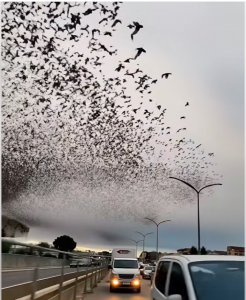Every winter, thousands of starlings migrate to Rome from northern Europe, forming massive flocks that resemble living clouds at sunset.
Each year, with the arrival of winter, the skies of Rome become the stage for one of the most fascinating natural spectacles in Europe: the arrival of thousands of starlings from the northern regions of the continent. These migratory birds seek refuge in the milder climate of the Italian capital, fleeing the intense cold of their native lands. Unknowingly, they become the stars of an aerial choreography that attracts both tourists and photographers from around the world.
During sunset, the starlings fly in enormous flocks that move with an almost magical precision. Their synchronized flight draws ever-changing shapes across the Roman skies, as if they were moving brushstrokes in the air. Some compare them to living clouds, others to waves of ink floating above. This aerial dance is as mesmerizing as it is mysterious, and has captured the curiosity of scientists, artists, and nature lovers alike.
However, not everything is beautiful. The massive presence of these birds also brings challenges. Their droppings cover streets, squares, and vehicles, leaving slippery surfaces and causing complaints from residents. Local authorities have implemented various strategies to scare them away—such as loud noises or flashing lights—but with little success. The starlings, used to urban disturbances, continue to return year after year without fail.
Despite the inconveniences, many consider this migration a visual gift that blends urban chaos with the majesty of animal behavior. Watching the starlings dance over the Colosseum or the Tiber River reminds us that even in the heart of a city as ancient as Rome, nature still holds the power to amaze us.

Ultimately, the winter invasion of starlings in Rome is a poetic display of survival, synchronization, and connection with the environment. A phenomenon that, while bothersome to some, represents one of the purest expressions of natural art.





